This post may contain affiliate links. If you make a purchase through an affiliate link, I will earn a commission at no extra cost to you. Thanks for your support.
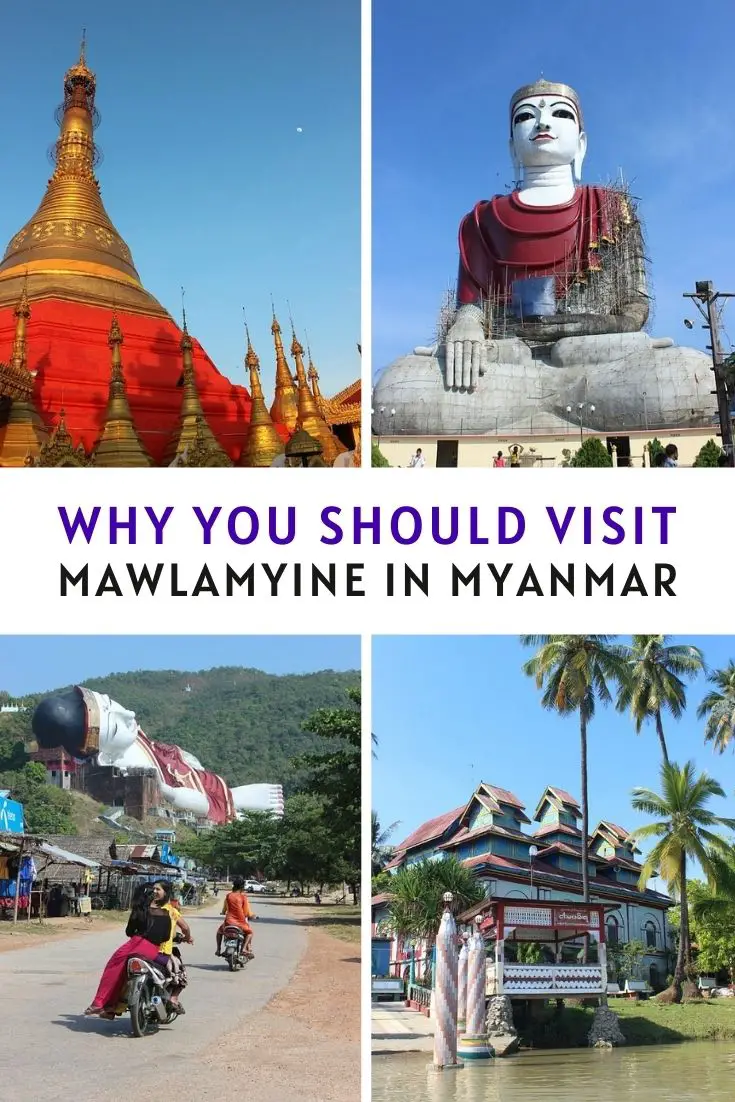
Exhausted, we exited the cramped quarters of the local bus after a long overnight journey from Inle Lake in the north of the country to Mawlamyine in the south. A dense tropical humidity replaced the dry, thin air of the lake.
It closed in around me, thick and cloying, as we bartered with tuk-tuk drivers, trying to negotiate a fair rate to our hotel.
We had arrived.
This city formerly known as Moulmein is the capital of Mon State and is the fourth largest city in Myanmar. A busy seaport at the mouth of the Thanlwin River, Mawlamyine is the main gateway to south-eastern Myanmar.
With only two short weeks allotted to this endlessly fascinating country, we probably wouldn’t have added this city, little known to tourists, to our itinerary had it not been for one thing: my great-uncle’s grave was nearby in the town of Thanbyuzayat.
That is why Dad joined me on this trip. He wanted to see where his uncle was buried. He died as a POW during World War Two, building the railway between Thailand and Myanmar for the Japanese which became known as the Death Railway.
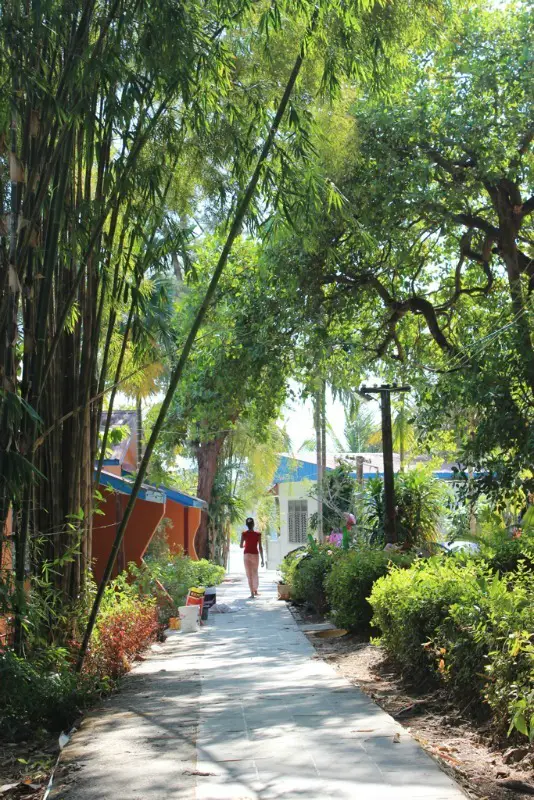
Checking into our hotel, I admired the pleasant view over the expanse of brown that is the Thanlwyn River from our fourth-floor room. The lack of sleep, tropic heat, and the beginnings of a cold had utterly exhausted me.
I didn’t leave the room for the rest of the day, choosing to order room service, watch movies on my laptop and get some much-needed rest.
But I was excited to be there. I could already tell it was different from anywhere else we had been in Myanmar. On the tuk-tuk ride to the hotel, we had passed lush jungle greenery edging in on the city. Nondescript squat buildings interspersed with graceful colonial architecture.
The city had a faded, gritty glamour, like a London or Paris of the jungle that had been left to decay for over half a century.
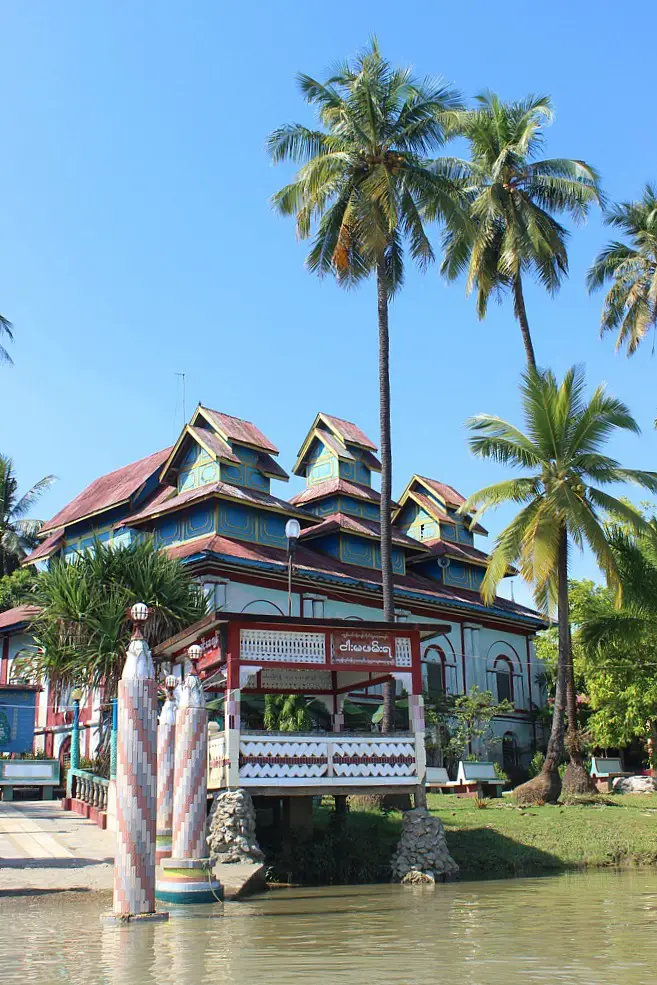
Understanding the Death Railway
The Japanese Army in World War Two were not exactly known for being kind (or humane in general) to their prisoners and the construction of the Burma-Thailand Railway, which later became known as the Death Railway, perhaps demonstrated this more than any other example.
From the years 1942-1945, the Japanese used POWs and Asian laborers to construct the railway as a way to transport men and supplies from northern Thailand to Burma. The terrain was unforgivingly harsh and conditions for the unfortunate workers were incredibly torturous.
Many men died during the construction from ill-treatment and exhaustion – over 90,000 people in three years. My great-uncle was one of them.
After all of that pain and suffering, the railway was only in operation for 21 months. What a horrific and pointless loss of life.
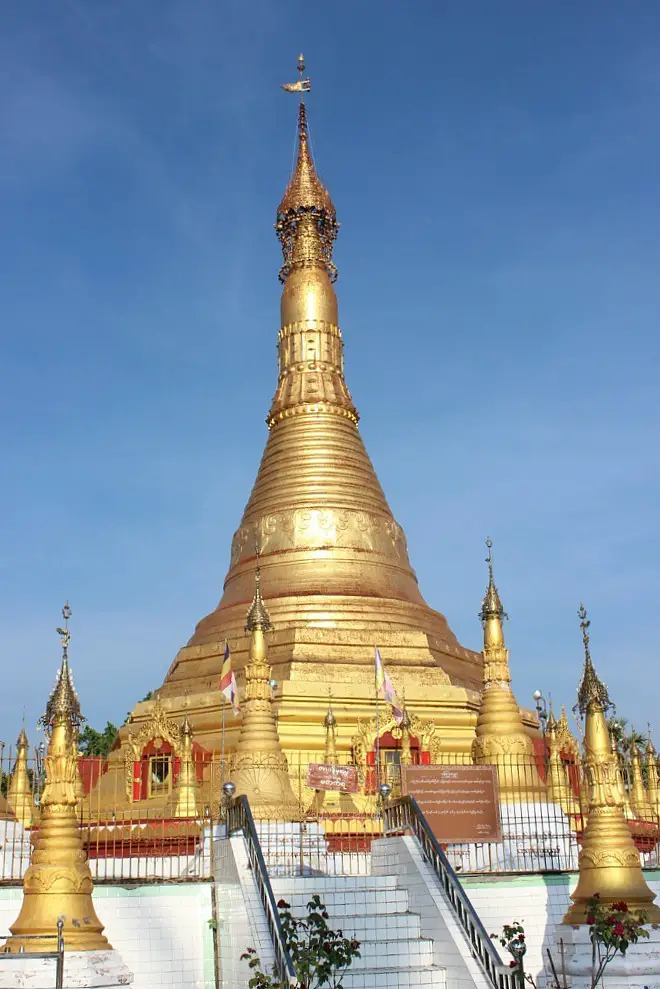
Our Half-Day Private Tour to Thanbyuzayat
On our first full day in Mawlamyine, we started slow, lingering over the breakfast buffet which included a selection of Chinese and Western options.
Hiring a car and driver for half a day, we drove south of the city, the chaotic press of buildings giving way to wide open fields and dense swaths of rich green jungle. We passed rocky and precarious hills that shot up to the heavens, delicate temples perched on their precipices.
Our first stop was at the Win Sein reclining Buddha at Mudon. It is the world’s largest reclining Buddha and is truly epic in scale. Despite its claim to fame, there were only a handful of people visiting when we arrived.
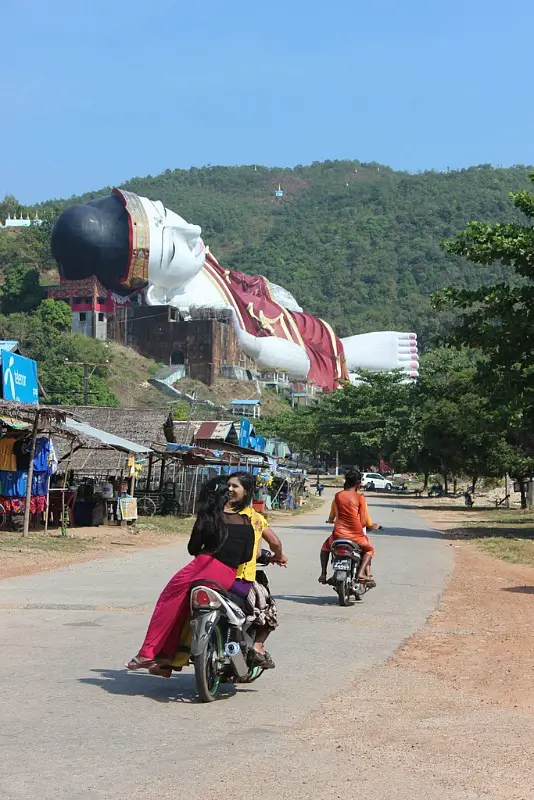
A group of Thai travelers who were on holiday were excited to see me and asked what I was doing there. They wanted their photo taken with me because I guess they didn’t expect to see a Westerner there so seeing me was a novelty.
That illustrates how few Western tourists you see in this part of the country. Encounters like this became common during our three nights in Myanmar’s southeast.
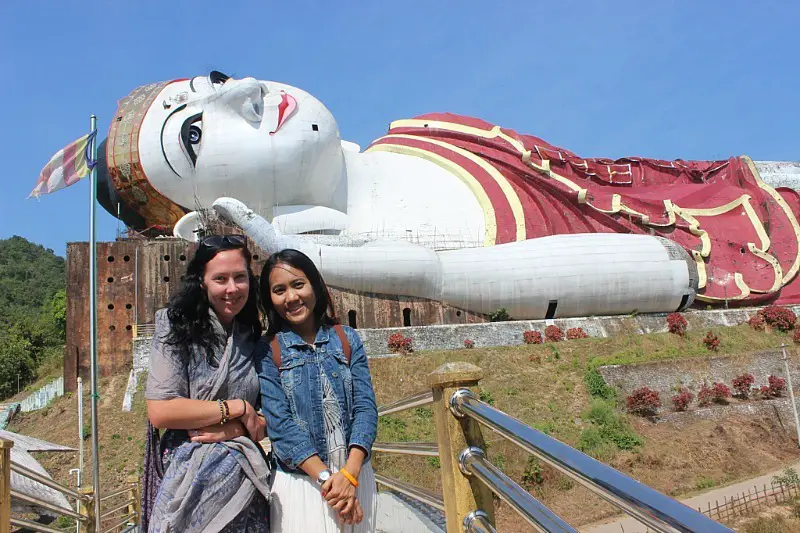
The inside of the Buddha was vast and cavernous. There were lots of empty halls but there was also a display of statues depicting Buddha’s life and what I can only imagine must be some kind of Buddhist hell.
Some nightmarish scenes included demons devouring humans, an eagle clawing out someone’s eye, and people burning in agony in a sea of fire. Lovely.
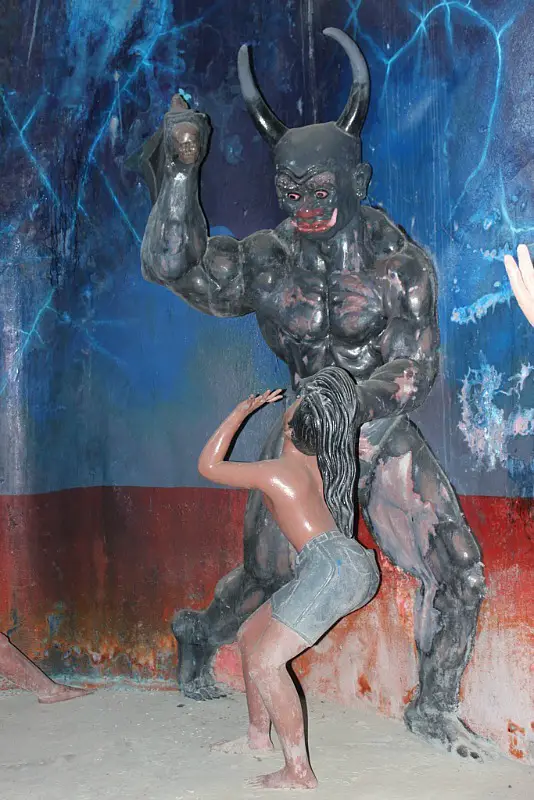
Back outside and away from the horror of the Buddhist Underworld, we continued to the town of Thanbyuzayat where the military cemetery was.
Like every allied military cemetery I have visited before, Thanbyuzayat Military Cemetery was a very well-kept cemetery, with simple but tidy graves that were perfectly spaced, freshly cut grass, and blooming flowerbeds.
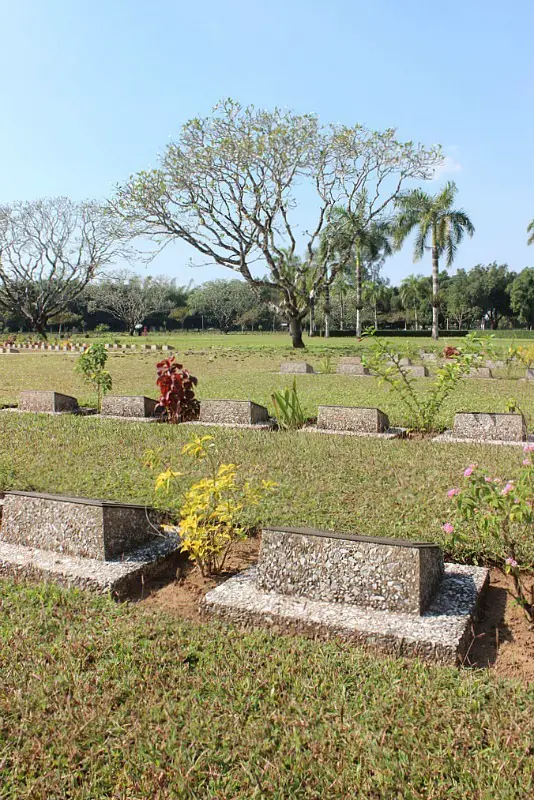
It isn’t a large cemetery and we found the grave easily; just a simple low stone marker with his name, Joseph Scott, his regiment, when he died, and his age. The funny thing is that half of the information on the grave was wrong – his real surname was in fact Bell.
Old Joseph had done a runner from his wife and child a few years before the war and had moved to Australia, changing his name so that he couldn’t be traced. He had also lied about his age so he could fight, saying he was six years younger than he actually was. I’m guessing he was the black sheep of the family.
In silence, we sat at his grave. It’s a weird feeling, sitting at a relative’s last resting place, one that you have never met before and who died long before you were even thought of, let alone born. Knowing they died in pain, that they were probably scared out of their minds. That the horror of their deaths is beyond what I could imagine.
He may have done some bad things in his life but he didn’t deserve to die as he did. Visiting his grave was a sign of respect and he deserves that.

After a while, a group of teenage girls came over and asked in broken English and hand gestures if they could have their photo taken with me.
Dad was in charge of the photo taking and the girls took their time, one by one, to get a photo sitting with me. On my dead great uncle’s grave. It was kind of surreal.
As this was happening, another group of teenage girls came up and started taking photos of me as the first group was leaving, they then got Dad to take a group photo of all of us. And with that, the spell had been broken and we left the cemetery.
Our driver took us to a local Burmese restaurant where we tried a selection of dishes from a buffet. Some of the meat and fish dishes were a bit too unusual for me but it was good to try something different. One of the most interesting experiences of the day came when I asked to use the bathroom.
The waiter pointed to go out the back; there was no bathroom in the building. I walked down a small alleyway surrounded by lean-to shacks, thick smoke from one of the shack dwellers cooking over an open fire made the air hazy. Scraggly chickens and dogs wandered the narrow alley, searching the dirt for scraps of food.
There was a communal outhouse at the end of the alley with a squat toilet and a basic shower for the people who lived there. More surrealness, it just kept on coming.
Before we left Thanbyuzayat, we stopped by the place where the Death Railway started. All that is there now is a piece of the track and an old steam engine. It was unremarkable but the thought of what this now peaceful spot represented in history sent a shiver up my spine.
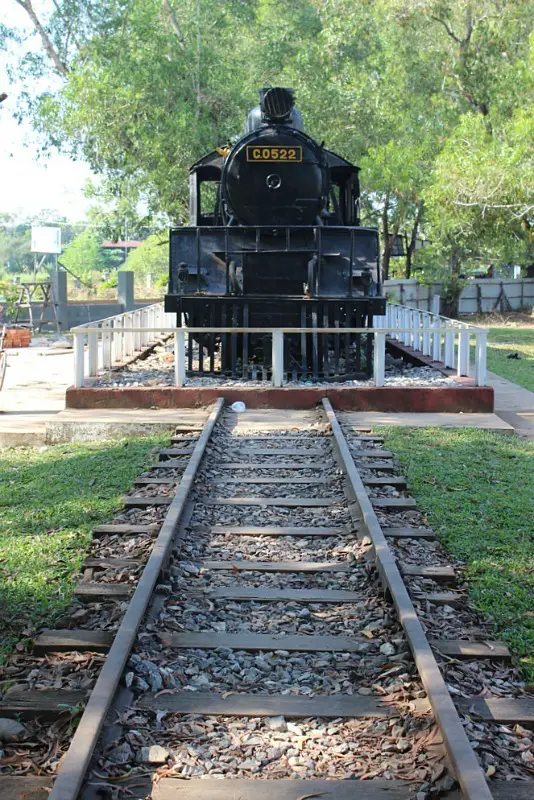
On the way back to Mawlamyine we stopped briefly at a partially constructed giant sitting Buddha, then at the Kangyi Pagoda which sits on a lake of the same name. After the crowds at the sitting Buddha, the pagoda was a welcome change.
It was a quiet spot and we were the only people there except for a couple of caretakers who were raking leaves. They warmly welcomed us, happy to have people to practice their English with. It was a short drive from there back to our hotel.
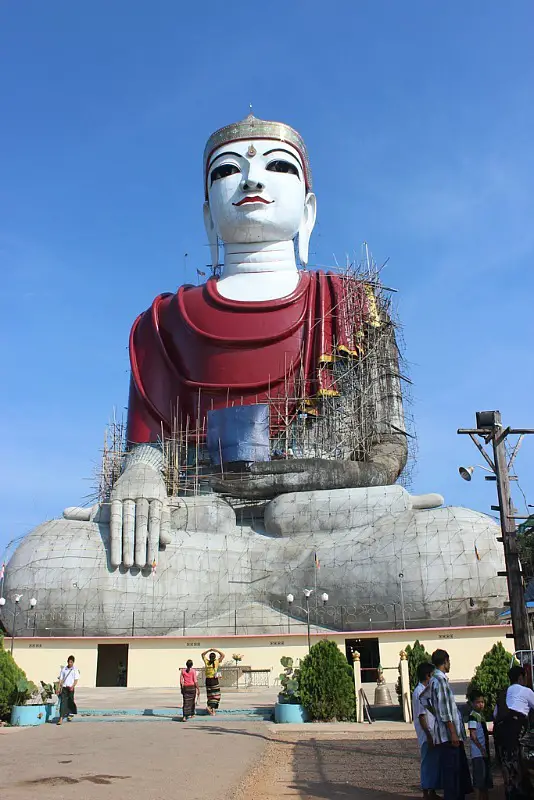
Our day touring the surroundings of Mawlamyine was over. The next day would be dedicated to exploring Mawlamyine itself.
A Day Exploring Mawlamyine
I had read about a small island on the river known as Shampoo Island, and due to my island obsession, I knew that we had to go there. A taxi dropped us beside the Thanlwyn River, directly across from the island and in the shadow of the Thanlwyn bridge that connects Mawlamyine and southeastern Myanmar to Yangon and the north.
A local guy took us across to the island for a small fee and we were pulling up at the dock within a few minutes of leaving the mainland.
Shampoo Island is small and overgrown with lush foliage. We wandered around aimlessly until we found a cluster of golden pagodas. An aggressive dog started following us, barking in displeasure at our presence. A local told us to leave in a language we did not know but with hand gestures that were obvious.
We weren’t welcome.
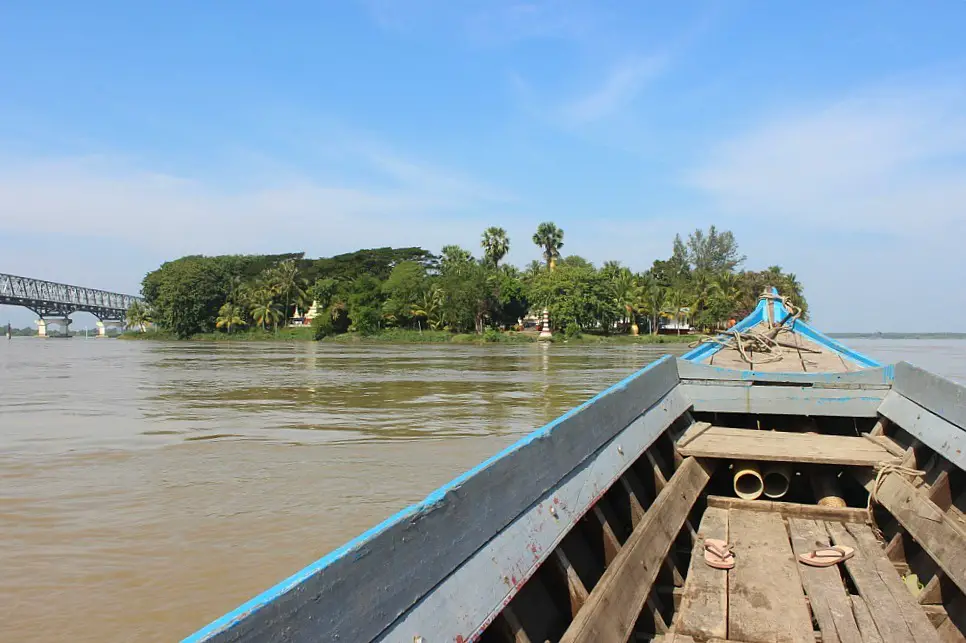
Walking around the other side of the island, another dog appeared and began to growl at us, its owner holding it back. It was time to leave this quiet island, it didn’t feel right being there. By that point, we had almost walked the circumference anyway.
The boat took us back to the mainland and we walked under the bridge, past a small makeshift village, and to the main road where we caught a cab back to our hotel.
The riverfront was a welcome place to escape the heat with large trees sheltering the waterside pathway. As we lazily followed the path, I heard people yelling from a barge on the river and looked over to see a big group of guys energetically waving and yelling out to us, trying to get our attention. Another celebrity moment.
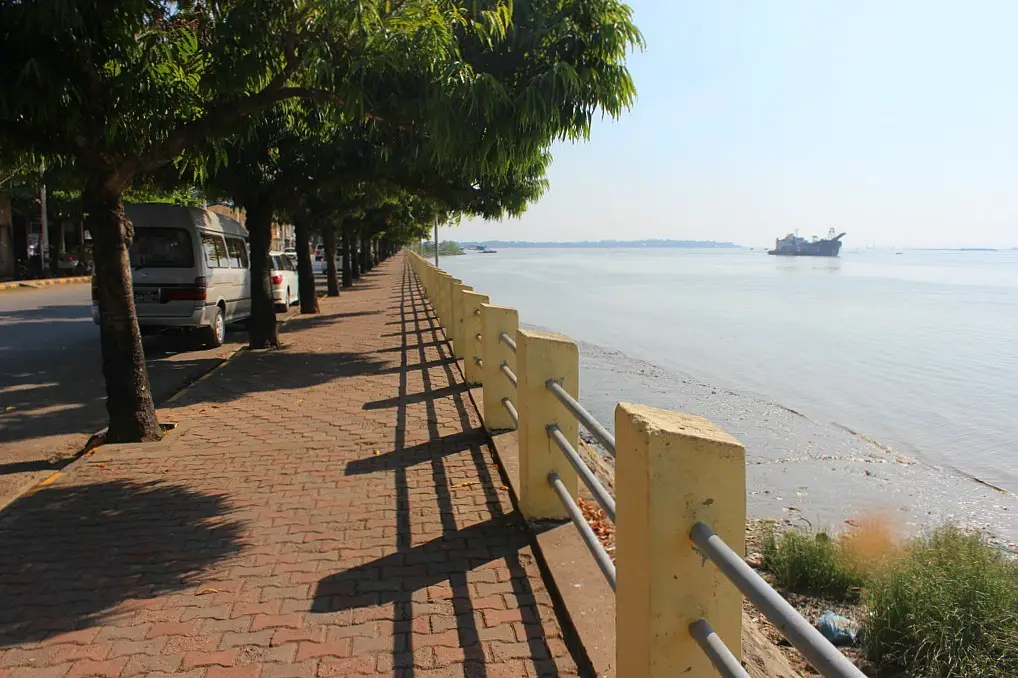
We ate seafood at one of the restaurants lining the riverfront. The menu was translated into English, a sign perhaps that more visitors are coming to Mawlamyine than I had supposed.
When the day began to cool we waited out the front of our hotel, trying unsuccessfully to hail a cab. Locals in cars and on scooters beeped and waved to us as they passed, massive grins plastered across their beaming faces. A taxi finally stopped, it was our driver from the day before.
Our destination was the famous Kyaikthanlan Paya, believed to be the ‘Old Moulmein Pagoda’ mentioned in Rudyard Kipling’s poem ‘Mandalay’. With a lofty perch on a ridge above the city, it was the perfect spot to watch the sunset.
The grandeur of the Paya was made known as soon as we reached the top of the stairs, and the resplendent golden pagoda did indeed have incredible 360-degree views. And there were kitties. Lots of kitties.
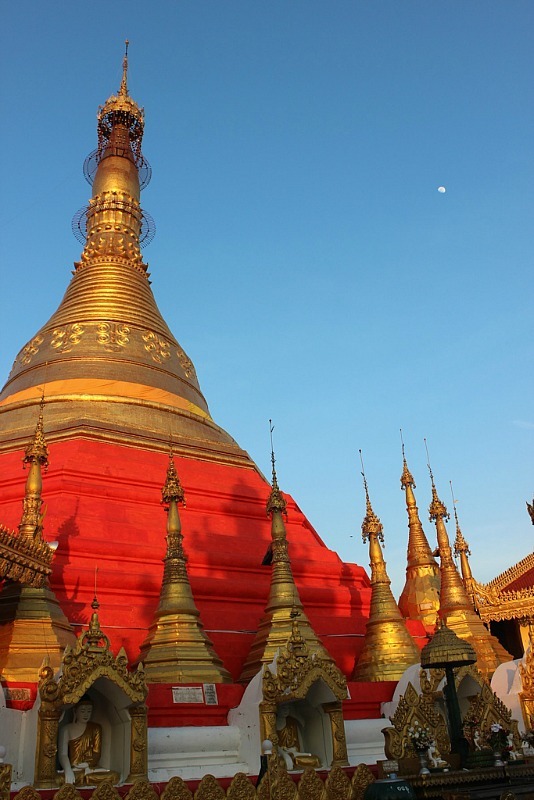
As the sun slowly edged closer to the horizon, I explored the temple complex and cuddled all the kitties that would let me close to them. There were a few people waiting for the sunset, sitting on a balcony looking out over the city.
I loved the contrast of the view from the other side of the complex, lush green fields and overgrown jungle stretching infinitely inland.
Witnessing the spectacular red sunset from Kyaikthanlan was nothing short of magical, one of the best sunsets I have ever experienced. It was even on par with the sunsets at Bagan, and that’s saying something.
Maybe the magic came from the important Buddha hair and tooth relics housed in the temple.
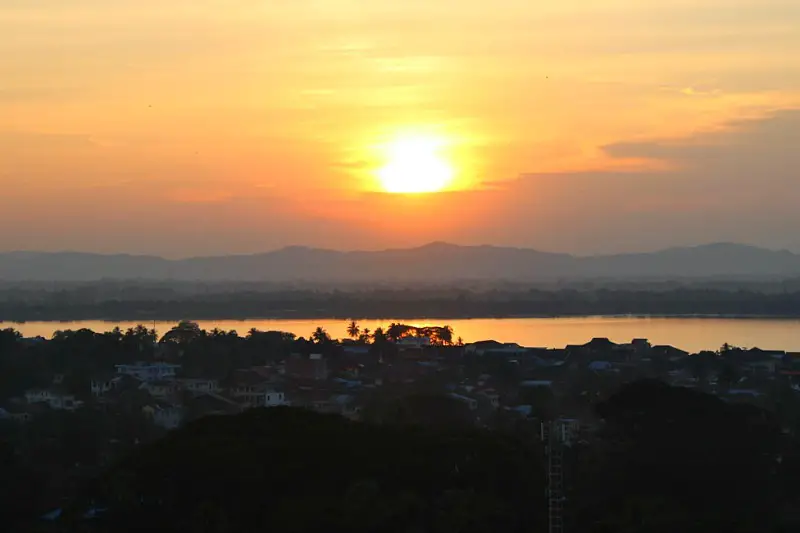
Our final night in Mawlamyine, and in Myanmar as a whole, was spent doing something that Dad and I both love: drinking beer and eating skewers.
A boisterous street market had been set up by the river and it worked the same way as on 19th Street in Yangon: you pick a vendor, selected which skewers you would like, then they are cooked and bought out for you. It was a great ending to our time in an incredible country.
Final Thoughts About Mawlamyine
Everywhere that we visited in Myanmar we found the locals to be friendly and curious, but nowhere more so than in and around Mawlamyine. I have never felt so much like a celebrity in my life.
I probably wouldn’t have gone to Mawlamyine if it hadn’t been for my Great Uncle but I am so, so glad that we did.
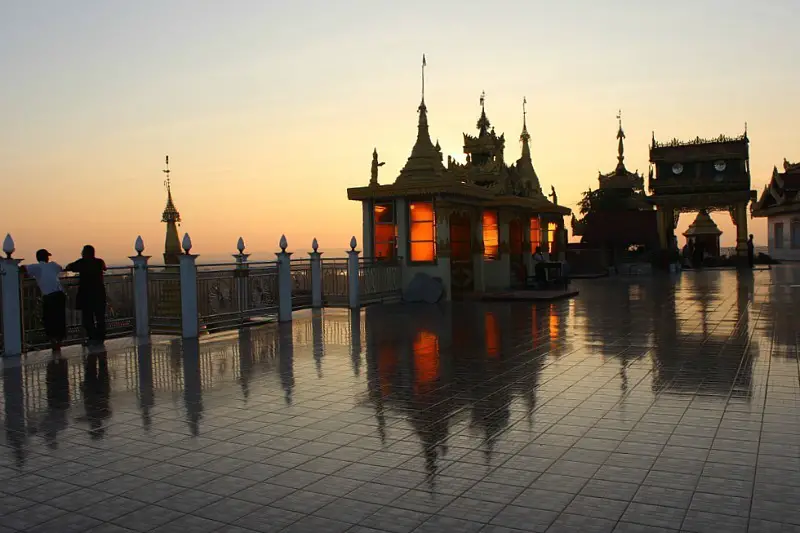
The Best Insurance For Your Myanmar Trip
Make sure you get travel and health insurance before your Yangon trip, just to be on the safe side. Safety Wing is my go-to and they are cheap and easy to claim with – it also auto-renews every month unless you turn it off so you don’t have to think about it on longer trips.
Safety Wing also allows you to sign up when you are already traveling, unlike a lot of other travel insurance providers.
Also, don’t forget to pack this awesome water bottle with a heavy-duty filter – it’ll allow you to drink from the tap, saving money as well as being more environmentally friendly.
If you liked this post, check out some of my other Myanmar content:
- The Perfect 2 Days in Yangon Itinerary For Your First Visit
- Why you Need to Visit the Bagan Pagodas in Myanmar
- Trekking Kalaw to Inle Lake: The Best Trek I Have Ever Done
- The Perfect Inle Lake Itinerary For Relaxation
PIN IT!
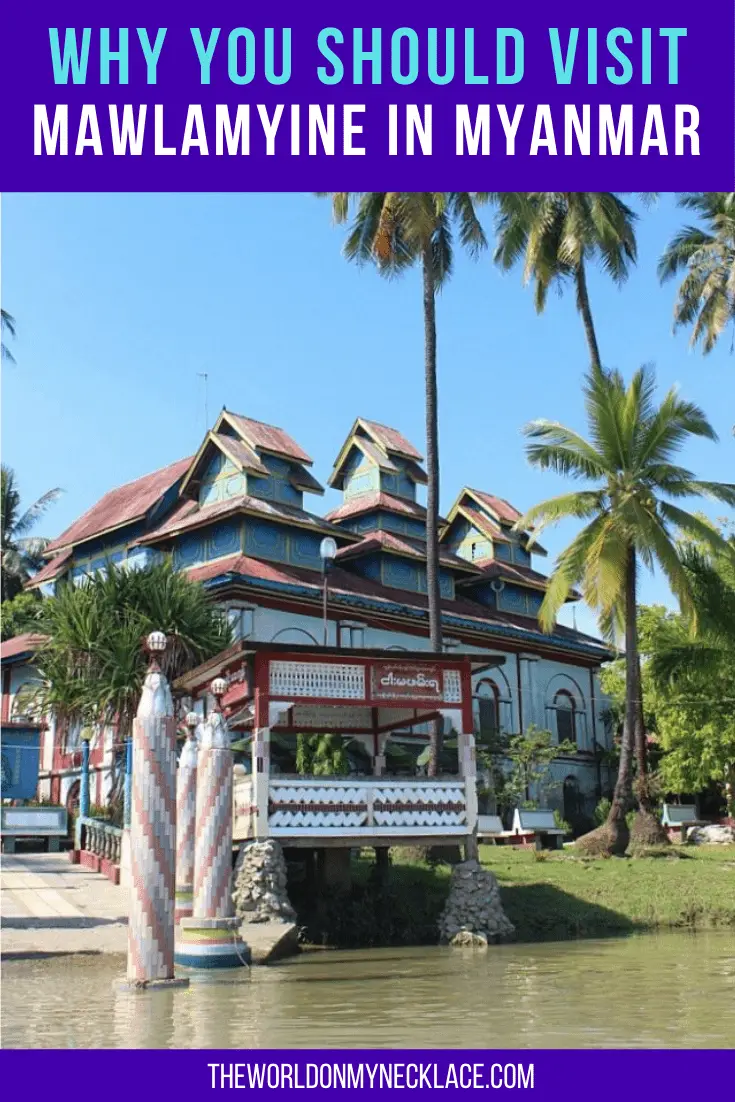
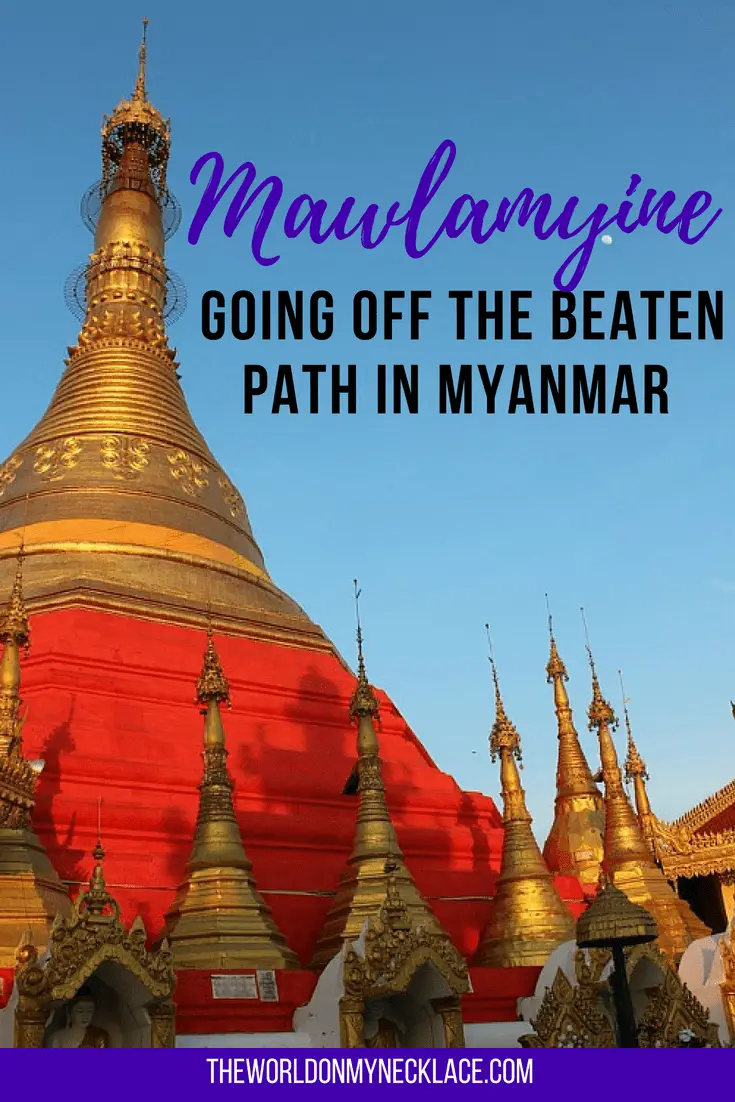

Hi, thanks for the great travel article on Mawlamyine. I’m interested. When did you go there? Thank you.
Jim (in Bangkok)
Hi Jim, it was a while ago. I was there in late 2015, just as Myanmar was opening up.